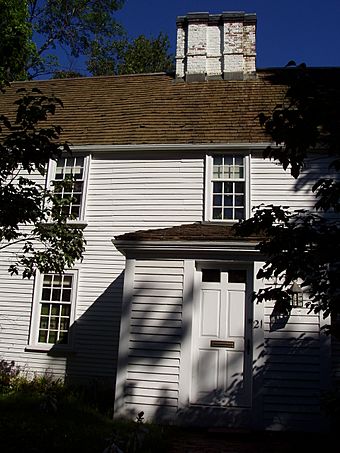Cooper–Frost–Austin House facts for kids
Quick facts for kids |
|
|
Cooper–Frost–Austin House
|
|

Part of front facade with enclosed porch
|
|
| Location | 21 Linnaean St Cambridge, Massachusetts |
|---|---|
| Built | 1681 |
| NRHP reference No. | 72000124 |
| Added to NRHP | September 22, 1972 |
The Cooper–Frost–Austin House is a very old and important house located in Cambridge, Massachusetts. It was built way back in 1681, making it the oldest house still standing in Cambridge today! This historic home is now a museum, cared for by an organization called Historic New England.
While it's not always open for everyone to visit, you can sometimes arrange a special tour during the summer months. It's a great place to learn about what life was like in Colonial America hundreds of years ago.
Contents
History of the Cooper–Frost–Austin House
The house was first built by Samuel Cooper. His father, Deacon John Cooper, had owned the land since 1657. The house was officially recorded in 1689 in a book about the lands and houses in "New Towne," which is what Cambridge was called back then.
How the House Grew Over Time
When it was first built, the house had one main room and a chimney section. It was two and a half stories tall. It also had a special "lean-to" section, which was like an extra part added to the side. Inside, there was a "low room," a "little room," a "kitchin," and chambers (bedrooms) upstairs. There was also a "Garret" (attic) and a "Cellar." All these original parts, including the chimney, are still there today!
Around 1720, Samuel Cooper's son made the house bigger. Later, between 1807 and 1816, Martha Frost Austin and Thomas Austin added even more. They built an enclosed porch and updated the inside with a new stairway and decorations in the Federal style.
Becoming a Museum
In 1912, the Cooper–Frost–Austin House was bought by Historic New England. This organization works to preserve old buildings and teach people about history. They have taken care of the house ever since, making sure it stays in good condition for future generations to see.
Uncovering the House's Age
In 2002, scientists from the Oxford Dendrochronology Laboratory studied the wooden beams inside the house. Dendrochronology is a cool way to figure out the age of wood by looking at its tree rings, just like you can tell a tree's age by counting its rings.
They found that the trees used to build the house were cut down in the winter of 1675–1676, the winter of 1680–1681, and the spring of 1681. This helped confirm that the house was indeed built around 1681. Some of the oldest wood might have been stored for a while before construction began.
See also


